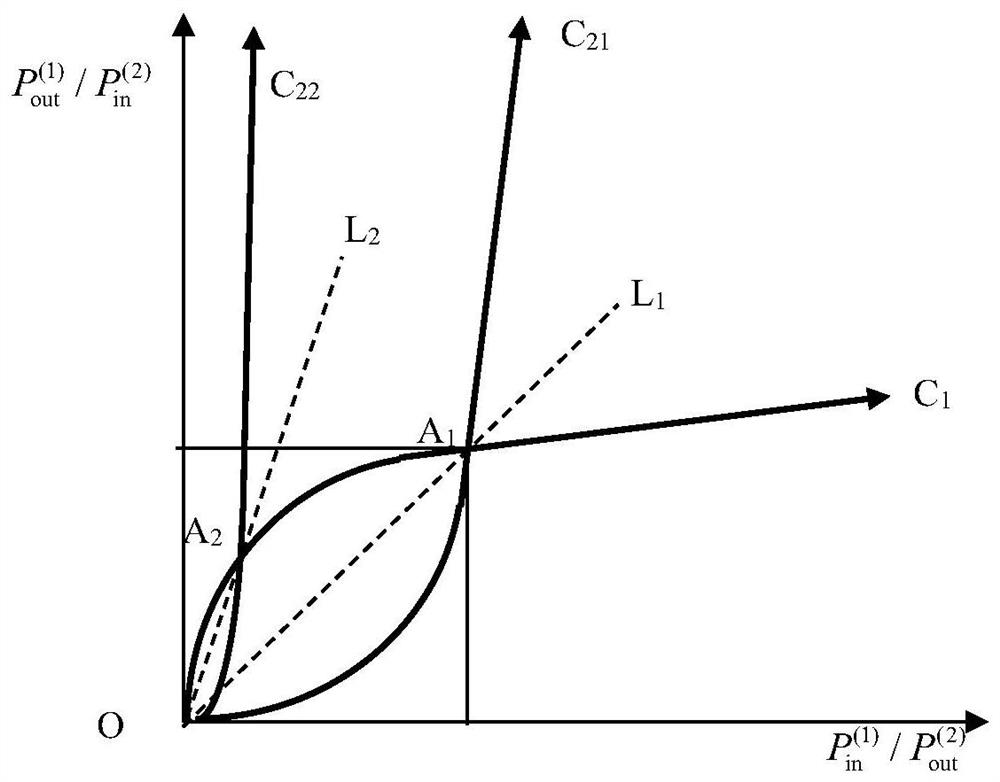Push-pull optical amplifier
An optical amplifier and fiber amplifier technology, which is applied to semiconductor amplifier structures, lasers, laser components, etc., can solve problems such as the decline of extinction ratio, and achieve the effect of suppressing gain saturation, small magnification, and improving signal-to-noise ratio.
- Summary
- Abstract
- Description
- Claims
- Application Information
AI Technical Summary
Problems solved by technology
Method used
Image
Examples
Embodiment 1
[0069] see Figure 1-3 , the main optical amplifying unit 1 and the auxiliary optical amplifying unit 2 are connected end to end to form an optical ring cavity with gain, thus becoming a laser.
[0070] Two optical amplifying units push-pull work, that is, when the main optical amplifying unit 1 is in the amplifying state, the auxiliary optical amplifying unit 2 is in a state close to locking; and when the auxiliary optical amplifying unit 2 is in the amplifying state, the main optical amplifying unit 1 is The amplified signal light is in a near-blocked state.
[0071] In order to set the wavelength to be amplified as λ 1 The optical signal is amplified, and a wavelength division multiplexer 3 and a wavelength division multiplexer 4 are respectively inserted between the main optical amplification unit 1 and the auxiliary optical amplification unit 2 .
[0072] In order to ensure that the resonant cavity formed by the push-pull optical amplifier can work in one direction, a f...
Embodiment 2
[0076] see Figure 1-3 , the main optical amplifying unit 1 and the auxiliary optical amplifying unit 2 are connected end to end to form an optical ring cavity with gain, thus becoming a laser.
[0077] Two optical amplifying units push-pull work, that is, when the main optical amplifying unit 1 is in the amplifying state, the auxiliary optical amplifying unit 2 is in a state close to locking; and when the auxiliary optical amplifying unit 2 is in the amplifying state, the main optical amplifying unit 1 is The amplified signal light is in a near-blocked state.
[0078] In order to set the wavelength to be amplified as λ 1 The optical signal is amplified, and a wavelength division multiplexer 3 and a wavelength division multiplexer 4 are respectively inserted between the main optical amplification unit 1 and the auxiliary optical amplification unit 2 .
[0079] In order to ensure that the resonant cavity formed by the push-pull optical amplifier can work in one direction, a f...
Embodiment 3
[0084] see Figure 1-3 , the main optical amplifying unit 1 and the auxiliary optical amplifying unit 2 are connected end to end to form an optical ring cavity with gain, thus becoming a laser.
[0085] Two optical amplifying units push-pull work, that is, when the main optical amplifying unit 1 is in the amplifying state, the auxiliary optical amplifying unit 2 is in a state close to locking; and when the auxiliary optical amplifying unit 2 is in the amplifying state, the main optical amplifying unit 1 is The amplified signal light is in a near-blocked state.
[0086] In order to set the wavelength to be amplified as λ 1 The optical signal is amplified, and a wavelength division multiplexer 3 and a wavelength division multiplexer 4 are respectively inserted between the main optical amplification unit 1 and the auxiliary optical amplification unit 2 .
[0087] In order to ensure that the resonant cavity formed by the push-pull optical amplifier can work in one direction, a f...
PUM
 Login to View More
Login to View More Abstract
Description
Claims
Application Information
 Login to View More
Login to View More - R&D
- Intellectual Property
- Life Sciences
- Materials
- Tech Scout
- Unparalleled Data Quality
- Higher Quality Content
- 60% Fewer Hallucinations
Browse by: Latest US Patents, China's latest patents, Technical Efficacy Thesaurus, Application Domain, Technology Topic, Popular Technical Reports.
© 2025 PatSnap. All rights reserved.Legal|Privacy policy|Modern Slavery Act Transparency Statement|Sitemap|About US| Contact US: help@patsnap.com



